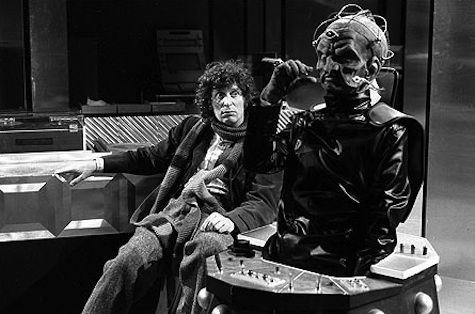Let it not be said that visiting your local used bookstore doesn’t pay off from time to time! I’m lucky in that I get to pop in to Singularity and Co., New York City’s resident sci-fi/fantasy depository, and luckier still that a few months ago I stumbled across a copy of The Doctor Who File by Peter Haining, originally published in 1986, unknowingly during the twilight of the classic series.
With the 50th anniversary of the show here, the book now presents a fascinating hindsight into the early days of Doctor Who, and a plethora of great photos and details, small and large, that may not be known to the fanbase at large. Did you know there was nearly a Doctor Who movie starring Tom Baker? Did you know one Doctor’s regeneration was inspired by Buddhism? Did you know that every time you see Davros there is a kilt hiding under that Dalek rolly-chair? You will!
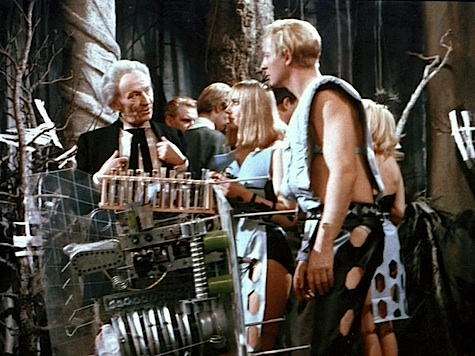
1.) Being the Doctor made William Hartnell’s life better. According to his wife Heather Hartnell, William could be unwittingly method with his acting and while he made his career playing heavies, the role of the Doctor made his declining years bright and cheery.
I was also delighted that Doctor Who got him away from the “heavy” roles. You have to remember that when you are playing the same part day in and day out, it begins to rub off. When he was playing the Doctor he was delightful to live with because he was so happy.
A happiness that literally followed him around! From the recollection of his wife:
My most enduring memory of this kind was in 1965 when he opened the big annual fete at Pembury Hospital in Kent. A friend of Bill’s had a beautiful old 1903 De Dion Bouton open touring car, and he used this to drive him to the fete.
The car had met Bill and myself in Tunbridge Wells where he had changed into his complete Doctor Who costume with wig, cape, and stick. Bill sat in the front with me in the back and we set off for the hospital. Well, by the time we had only gone a few miles, there was a whole cavalcade of children and cars and bicycles following us!
2.) Early script writers for Doctor Who had to be separated into those who could do stories set in the past and stories set in the future. From the show’s first script editor, David Whitaker:
I found that writers had to be divided into those who could write about the past, and those who set their stories in the future. Strangely, very few could do both. There were those who thought the futuristic stories would be easier because the scope was so wide, but in fact we had to set quite strict limits so that everything remained at least reasonably plausible!
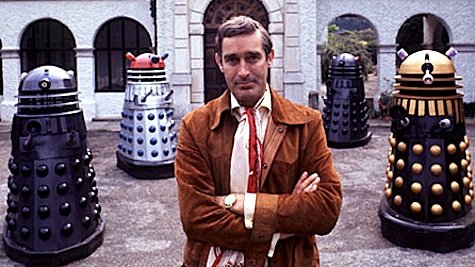
3.) Terry Nation, the imagination that birthed the Daleks, is a very very anxious person. The portion of the book written by Dalek creator Terry Nation is a fascinating snapshot of the man’s personality. His inspiration for the Dalek episode “Genesis of the Daleks”:
My inspiration for the story came from something I saw as a kid—a movie based on H.G. Wells’ novel Things To Come, which was made in 1936 with Raymond Massey and Ralph Richardson. There everybody had reverted almost to primitivism. Technology had run out and they were going back to more and more basic things. But still they were building this great spaceship.
Somewhere, too, there was this corps of elite people who still had their priorities. In fact, I believe that it has already been arranged in our own society that if someone should press the destruction button or release a terrible virus, then there are groups of elitists who will be protected until the very last moment because the future of mankind is in the hands of these elements.
And that’s why in “Genesis of the Daleks” I called Davros’ force “The Elite.”
It gets stranger….
Survival has, in fact, been a theme that has gone through a lot of my work. I see minefields all around me. I’m a bit like Walter Mitty, really—when I’m in an aeroplane I’m just waiting for the moment when someone says, “Can anybody fly this plane?”
Now, I know that I can’t, but I also know that, finally, I am going to be the one who has to do it!
I believe there is menace all around us.
Wait, Terry, so are you saying….
I have a dream that recurs about once or twice a year. I am driving a car very quickly and the windscreen is a bit murky. Then, suddenly, the sun shines onto it, and it becomes totally opaque. I’m still hurtling forward at an incredible speed and there’s nothing I can see or do, and I can’t stop the car.
That sounds intense and frightening.
The Daleks are all of “them” and though they represent different things to different people, everyone sees them basically as government, as officialdom, as that unhearing, unthinking, blanked-out face of authority that will destroy you because it wants to destroy you.
4.) Every time you see Davros, he’s wearing a kilt. Michael Wisher, who played Davros in “Genesis of the Daleks” describes the process thusly:
…right from the start I found that there were special problems in playing Davros. It was easy to become disorientated seated in the trolley with the mask on. You can’t see properly, you can’t hear properly, and though you may think you know your lines perfectly, when it comes to doing them in costume you can dry up because you can’t see who you’re talking to! It is also very uncomfortable half-crouching inside the trolley, and when I found that wearing trousers made it because they rubbed [sic], I opted to wear a kilt!
And if those aren’t enough problems, there is also the little matter of going to the loo from time to time. I tried using the blue light to indicate what I wanted. Then in desperation I sneaked a bottle into the costume—but gave the game away when I tipped it over and left little puddles all over the floor!
I looked a pretty bizarre picture during lunch breaks, too. A figure in kilt and gymshoes unable to eat anything through the mask, only take drinks, and I had to use a long cigarette holder if I wanted a smoke to avoid setting fire to myself. I got some most peculiar looks!
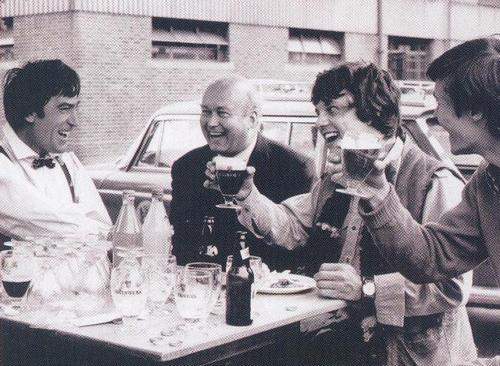
5.) Second Doctor Patrick Troughton wanted to be snuck back onto the show as a monster during the Sixth Doctor’s reign. Via Troughton himself:
I wouldn’t mind appearing in Doctor Who again, either. It would be nice to remake “Evil of the Daleks,” which was a classic, as a full-length feature film. […]
Most of all I’d love to sneak back in a cameo part disguised as one of the monsters. It would have to be without anyone knowing and with no credit in the Radio Times.
But just imagine—the Doctor as a Yeti or even a Cyberman!
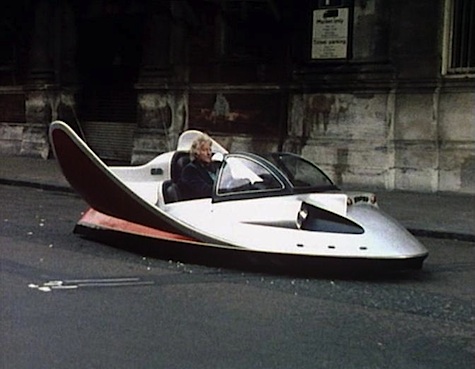
6.) The Third Doctor helped design the Whomobile. And loved every minute of it! From Pertwee:
Remember the Whomobile which I helped to design with two engineers from Nottingham who specialised in sprint cars? The vehicle had a pepped-up engine and I had to lie down to drive it rather like a Grand Prix racing car. Inside it there was a TV, stereo, a telephone, and what we called a “computer bank.” It was probably the most revolutionary vehicle ever made for the series.
7.) The Third Doctor’s regeneration is meant to be a parable on Buddhist meditation. Show producer Barry Letts explains what’s really happening in “Planet of the Spiders,” the episode where the Third Doctor regenerates into the Fourth.
“Planet of the Spiders” (1974) which Robert Sloman wrote came about for two reasons. I am a Buddhist (though I dislike such labels) and, although not many people realised it at the time, the Spiders’ story was a parable about Buddhist meditation.
Sometimes greed can take over the selfish Ego and can use the mind to gain power, rather than allow itself to be destroyed—which is the point of meditation. In “Planet of the Spiders,” the Great One represented this Ego. However, the Doctor by going into the depth of the Blue Mountain (i.e. into his own self) was the means of destroying the Ego and in the process was transformed into the “new man”—that is, Tom Baker!
8.) The Third Doctor was the first incarnation of the character that behaved like the superhero we often consider him to be.
Although this isn’t stated outright by Jon Pertwee, the interview with him does make it clear that Pertwee and the show producers at the time wanted to depict the Doctor as more of an action hero, as opposed to the trickster or professor that they and the viewers were accustomed to. This decision has obviously reverberated throughout the show, and these days it’s actually weird if the Doctor isn’t a little bit physical during his adventures. Although, perhaps admirably, it’s still very out of character for him to outright physically attack anyone.
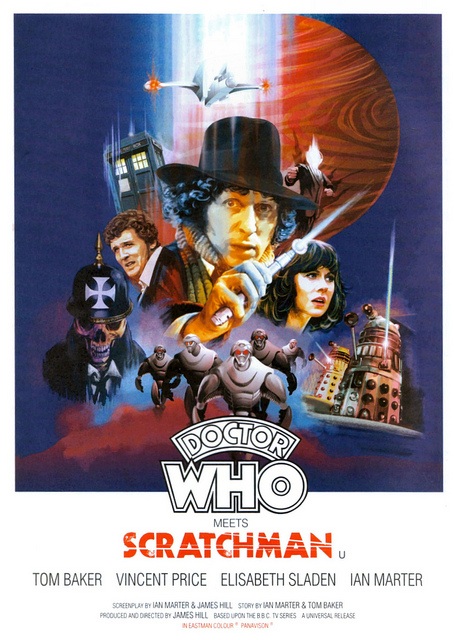
9.) The Fourth Doctor and Harry wrote a Doctor Who movie that never got made. And he fights the devil. Tom Baker and Ian Marter relate why Doctor Who Meets Scratchman never came to fruition. First, the plot:
We wanted to keep the cast small—The Doctor, a male and a female associate and a villain called Scratchman (an ancient name for the Devil) plus a number of minor characters. Our monsters were to be scarecrows and a horde of quasi-cybernetic goblins in Scratchman’s pay. […]
The eccentricity and the Britishness of the television show were deliberately emphasised. The trigger for Tom’s plot was an amateur game of cricket played by the Doctor and his friends on a picnic and our climactic final scene neatly tied this up with another game of cricket, this time in celebration of their victory over Evil. But was it a victory? Had Scratchman perished or had he escaped? We deliberately made the ending ambiguous so that if the film was a success, then a sequel might be possible!
Then the production details:
Tom brought film director James Hill into the project to collaborate in the preparation of a draft screenplay and to draw up a preliminary budget. We worked as often as our separate commitments allowed at Tom’s place or at James’ delightful and eccentric house in Shepherds Bush and at last the screenplay was printed and the budget completed.
To reduce production costs, we planned to shoot the film almost entirely on location in Scotland, and probably on Lanzarote in the Canary Islands, where the volcanic wasteland would be ideally suited to the story. There was to be one gigantic finale scene in the studio.
By now we had a script, a budget, a director and an agreement with the BBC assigning us the film rights for two years.
All we needed now was the money!
About the money needed:
…we knew that we could not hope to raise all the capital in the UK. So in addition to the Film Finance Corporation here, approaches were made to the organisations like Warner Brothers, Disney, Hammer, Roger Corman, Universal, and many others. […]
Months went by. Hopes were raised, only to be dashed again. We had encouraging reactions from several prospective stars. Vincent Price expressed great interest in the role of Scratchman and Twiggy liked the idea of playing the Doctor’s young lady companion. […]
But after months of effort and despite the possibility of a promising cast we had only a small proportion of the money in sight. Our optimism began to fade.
George Lucas lands the killing blow:
And then one day Tom rang to suggest that we go see the press preview of a new science-fiction blockbuster from America called Star Wars. Next day we emerged from the Dominion Cinema into the cold grey wet of Tottenham Court Road feeling utterly dejected. The film we had just seen told us that we were too late. The scale of our project was far too small. Science-fantasy was obviously going to be in…but on a new and on a vaster scale than ever before. Our project would be a minnow among the whales!
10.) Ford Prefect from The Hitchhiker’s Guide to the Galaxy was created by Douglas Adams as a reaction against the Doctor. Show writer Douglas Adams says it himself:
You see, the Doctor is always rushing around and saving people and planets generally doing good works, so to speak. I thought the keynote in the character of Ford Prefect was that, given the choice between getting involved and saving the world from some disaster on one hand, and on the other going to a really good party, he’d go to the party. Every time. So that was the departure point for Ford.
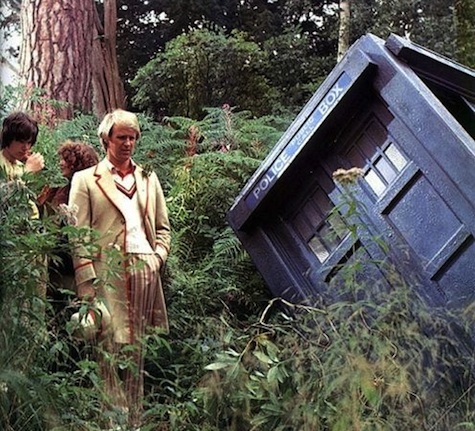
11.) Peter Davison was the first Doctor who had grown up watching the show. In the book, Davison relates meeting Patrick Troughton after being cast and being warned not stay longer than three years. (A warning which current Doctors still heed.) Troughton’s Second Doctor was the one Davison “had most watched as a kid.”
Although the book was compiled and released after Davison’s tenure as the Doctor had concluded, the actor states that he is always up for returning to the part! (Oh the future in store for him…)
12.) Tom Baker was originally the star of “The Five Doctors.” Script writer Terrance Dicks’ original plan for the celebratory special was to have the Fourth Doctor steal the Master’s TARDIS and head to Gallifrey to unravel Borusa’s plot while the other Doctors fought off the threats in the Death Zone.
13.) Speculation on whether the Doctor could be a woman stretches at least as back to the Sixth Doctor, according to the Sixth Doctor Colin Baker:
…Colin nearly went after the role when he read in the newspapers in October 1980 that Tom Baker was leaving the show. […]
“…when Tom Baker finished as Doctor Who, I thought, I’ll ring my agent and have a go at that. But before I could do anything they announced Peter Davison had got the job.”
When, in the summer of 1983, Peter Davison announced that he was about to bow out, Colin’s reaction was quite different.
“This time I read that they were looking for an older Doctor, or even a woman, so the idea of going after the part didn’t even cross my mind.”
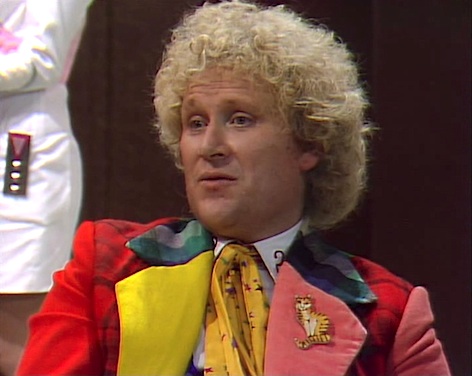
14.) The Doctor IS a cat person! Colin Baker explains why he added the cat pin on the Sixth Doctor’s costume:
As Peter had utilized his love of cricket, I thought I’d employ my love of cats. The badge is intended to be symbolic. There is a quotation which says, “I am the cat that walks by himself and all places are the same to me.” Now if you stick the word “times” in there it becomes, “I am the cat that walks by himself and all times and places are the same to me.” And I think that sums up the Doctor, too, like a cat prowling through life, very contained, very sure of himself and yet capable of doing ridiculous things!
15.) Hindsight can be so sad. Colin Baker, speaking from the midst of his tenure, on his hoped-for longevity:
At the moment, having waited so long for a chance to play the Doctor, I can’t bear to think of anyone having played it longer than me. So that means, I suppose, I shall have to do it for longer than Tom Baker—seven years!
The entirety of The Doctor Who File book is full of amazing photos, drawings, and recollections from Doctors, writers, and showrunners that have since passed on. It’s worth tracking down if you can find a copy on the cheap!
Chris Lough is the resident Tor.com Agents of S.H.I.E.L.D. and Doctor Who overfocusamatron and one day, probably soon, all TV shows shall be the same to him.










